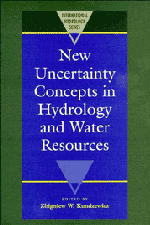Book contents
- Frontmatter
- Contents
- List of Authors
- Preface
- I INTRODUCTION
- II FACETS OF UNCERTAINTY
- III NOVEL APPROACHES TO UNCERTAINTY: FRACTALS, FUZZY SETS AND PATTERN RECOGNITION, NON-PARAMETRIC METHODS
- IV RANDOM FIELDS
- V TIME SERIES AND STOCHASTIC PROCESSES
- 1 Prediction uncertainty in seasonal partial duration series
- 2 A daily streamflow model based on a jump-diffusion process
- 3 The influence of time discretization on inferred stochastic properties of point rainfall
- 4 The distribution of the l-day total precipitation amount
- 5 Analysis of outliers in Norwegian flood data
- 6 Stochastic modelling of the operation of hydrants in an irrigation network
- 7 Order and disorder in hydroclimatological processes
- 8 Towards the physical structure of river flow stochastic process
- VI RISK, RELIABILITY AND RELATED CRITERIA
2 - A daily streamflow model based on a jump-diffusion process
Published online by Cambridge University Press: 07 May 2010
- Frontmatter
- Contents
- List of Authors
- Preface
- I INTRODUCTION
- II FACETS OF UNCERTAINTY
- III NOVEL APPROACHES TO UNCERTAINTY: FRACTALS, FUZZY SETS AND PATTERN RECOGNITION, NON-PARAMETRIC METHODS
- IV RANDOM FIELDS
- V TIME SERIES AND STOCHASTIC PROCESSES
- 1 Prediction uncertainty in seasonal partial duration series
- 2 A daily streamflow model based on a jump-diffusion process
- 3 The influence of time discretization on inferred stochastic properties of point rainfall
- 4 The distribution of the l-day total precipitation amount
- 5 Analysis of outliers in Norwegian flood data
- 6 Stochastic modelling of the operation of hydrants in an irrigation network
- 7 Order and disorder in hydroclimatological processes
- 8 Towards the physical structure of river flow stochastic process
- VI RISK, RELIABILITY AND RELATED CRITERIA
Summary
ABSTRACT The objective of this paper is to describe daily discharge series by a stochastic differential equation which is based on the mass balance of a linear reservoir. The input consisting of a series of jumps reflects the rainfall while the output refers to the discharges of a river basin. To account for random phenoma such as evaporation during the transformation process a perturbation term was introduced. The point process describing the shots (jumps) is based on an intensity function alternating randomly between two levels. Thus clustering of shots can be incorporated into the model.
INTRODUCTION
Numerous stochastic models have been applied to streamflow series. They can be grouped, for instance, into ARMAtype models (Fiering, 1967; Hipel et al., 1917; Noakes et al 1985; Kottegoda & Horder, 1980; Salas & Smith, 1981), long term memory models such as fractional Gaussian noise models (Mandelbrot & van Ness, 1968; Mandelbrot & Wallis, 1969) and related broken line models (Meija et al., 1972). The third class of models refers to the transformation of an intermittent rainfall process into a continuous discharge series (Treiber & Plate, 1975; Weiss, 1973, 1977; Miller et al., 1981; Kavvas & Delleur, 1984; Koch, 1985; Bodo & Unny, 1987). In this paper daily streamflow series (Beard, 1967; Quimpo, 1967; Valencia & Schaake, 1973; Mejia & Rousselle, 1976; Yakowitz, 1979; Morris, 1984; Miller et al 1981; Weiss, 1977; O'Cornell, 1977) are being modelled.
- Type
- Chapter
- Information
- New Uncertainty Concepts in Hydrology and Water Resources , pp. 225 - 229Publisher: Cambridge University PressPrint publication year: 1995
- 2
- Cited by



